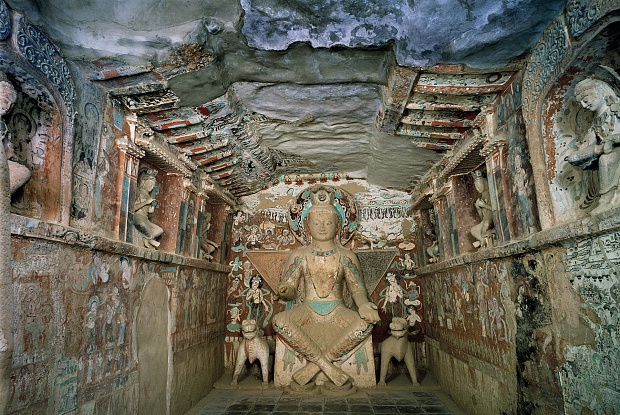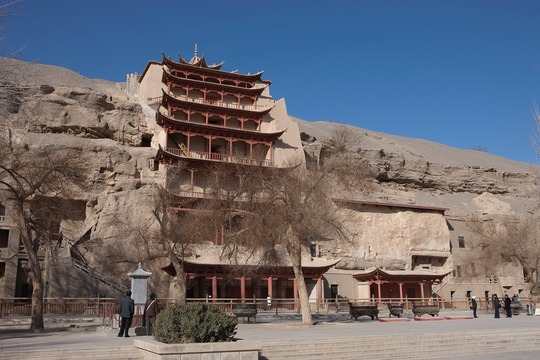DepthReading
Silk Road leads to Los Angeles as Getty show recreates Mogao Grottoes
Silk Road
leads to Los Angeles as Getty show recreates Mogao Grottoes
Long-term China-US project produces
replicas of caves from the ancient world’s “information superhighway”
by EMILY SHARPE | 14 June 2016
View of the interior of Cave 275 showing a sculpture of a bodhisattva, Northern Liang dynasty (AD420–429). Photo: Wu Jian. © Dunhuang Academy
The Mogao Grottoes, a collection of more than
500 ancient Buddhist temples carved into the cliffs near Dunhuang in
north-western China, were a key stop for the intrepid travellers who exchanged
goods and information on the Silk Road—the ancient equivalent of the
information superhighway. Dunhuang was one of the first trading cities in China
encountered by Western merchants, and the final supply stop for those making
the long push westward, so travellers visited the richly decorated temples
(dating from the fourth to the 14th centuries) to pay their respects.
Fast-forward more than 500 years and the Unesco World Heritage Site remains a
popular tourist destination.
The caves
face a number of preservation challenges, so for the past 27 years, the Los
Angeles-based Getty Conservation Institute (GCI) has been working with the
Chinese government and the Dunhuang Academy to ensure that the grottoes and
their decorative interiors survive. This work is the basis for the Getty
Center’s exhibition Cave Temples of Dunhuang: Buddhist Art on China’s Silk Road
(until 4 September), which brings a piece of the Silk Road to Los Angeles in
the form of artefacts, life-sized cave replicas and cutting-edge technology.
Taming the elements
Neville Agnew, a senior project specialist at
the GCI, says that controlling the influx of wind-blown sand from nearby dunes
was one of the first issues addressed when the project began in 1989.
“Thousands of cubic metres of sand had to be removed by hand each year,” he
says. The movement of sand over the cliff had worn away the rock to such an
extent that some of the caves’ roofs had thinned and collapsed. The solution
was surprisingly simple: erect a 6ft-high, three-mile-long fence made from a
synthetic knitted fabric, at a cost of around $15,000, and create a natural
barrier by planting desert-adapted local species of plants and shrubs. Agnew
says that these measures have reduced the sand problem by 60%.
Cave
96—a nine-storey temple housing a colossal Tang dynasty Buddha. © Dunhuang
Academy
Guided by the GCI’s “whole-body medicine”
approach to site preservation, in which elements are looked at together and not
in isolation, the early years of the project focused on assessing the site,
which included monitoring the weather and temperature levels, examining the
rock’s geological stability (the site is in an earthquake zone) and identifying
pigments and the extent to which they had changed over time. They also ran
training programmes for local people.
Finding
the source of moisture or water vapour in the caves was difficult because it
comes from several places. The salt in the rock absorbs this moisture and
liquefies; when it dries out, it crystallises. This repeated act of
liquefaction and crystallisation harms the wall paintings. Agnew says that,
although visitors “may raise the cave’s humidity levels by 5% over the ambient
[levels]”, the repeated act of opening and closing the doors when humidity
levels are high is the more pressing concern, because it “allows for a rapid
exchange of air” inside and outside.
Protecting Big Buddha Cave
Around one million tourists visit the 60 or so
caves that are open to the public each year. Although different caves are
accessible from year to year, there are four on everyone’s “must-see” list,
including the Big Buddha Cave—a nine-storey structure built in the seventh
century to house a 35.5m-high Tang dynasty Buddha. A visitor management plan,
developed to determine how many people could visit the cave without having a
negative impact on it, found that the ideal number is 6,000 people, spread
evenly throughout the day. A visitors’ centre was built ten miles from the site
to help to control the flow of tourists.
Cave 85
was used as a ten-year case study to determine how to conserve the site’s wall
paintings. The late Tang dynasty cave (AD848-907) suffers from the same issues
as others in the complex. The painted mud plaster’s detachment from the rock
“continues to be the single greatest threat to the wall paintings”, Agnew says.
This separation probably occurred soon after the caves were finished, but “was
exacerbated by the build-up of salts”. Ceiling decorations are particularly
vulnerable, especially in this earthquake-prone area. The team studied salt
extraction, analysed the pigments and binders and researched which materials
were best for re-laying the lifting paint. They also developed a technique to
adhere the wall paintings to the underlying rock and experimented with a new
display that encouraged visitors to view the paintings, lit by LED lights, from
a raised platform.
Three of
the eight cave replicas commissioned by the academy are in the Getty’s
exhibition. They were hand-painted by a team of artists who “described [working
on them] as almost a spiritual exercise”, Agnew says. Visitors to the exhibition
can also experience the caves in 3D, with the aid of stereoscopic immersive
technology, and can see around 40 of the 50,000 manuscripts, silk paintings and
sketches from the Library Cave. Among the key pieces from this cave is the
frontispiece of the Diamond Sutra (AD868)—a sacred Buddhist text that is said
to be the earliest completed book. The piece has been lent by the British
Library in London.
Agnew
hopes that visitors will experience the same awe felt by people hundreds of
years ago. “It must have had an immense impact on travellers coming out of the
desert. They probably thought they were in paradise,” he says. “It’s akin to
Medieval peasants visiting the cathedrals in Europe and being struck dumb by
their wealth, beauty and grandeur.”
Category: English
DepthReading
Key words:


